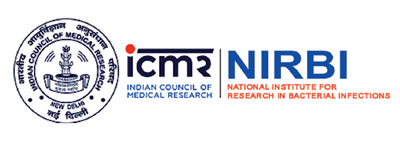ICMR - National Institute for Research
in Bacterial Infections
आईसीएमआर - राष्ट्रीय जीवाणु संक्रमण अनुसंधान संस्थान
Department of Health Research, Ministry of Health and Family Welfare, Government of India
स्वास्थ्य अनुसंधान विभाग, स्वास्थ्य और परिवार कल्याण मंत्रालय, भारत सरकार
WHO Collaborating Centre For Research and Training On Diarrhoeal Diseases
Pathophysiology
Pathophysiology

The Division of Pathophysiology's research focuses on elucidating the role of microbial proteases in pathogenesis. This Division also investigates the potential of microbial proteases in anti-cancer therapies, particularly colon, gastric, ovarian, and breast cancers. The division's primary areas of interest are: A. The role of microbial proteases in cancer therapeutics, and B. The role of microbial proteases in bacterial pathogenesis.
Highlights of some of the projects are as follows:
A. Role of microbial protease in cancer therapeutics:
Conventional tumour therapies are relatively non-specific, show
dose-limiting side effects and develop drug resistance. For
being a good therapeutic agent it should kill malignant cells
specifically without altering the survival of normal healthy
cells. This is possible by microbial protease mediated targeted
strategies that disrupt oncogenically active cell surface
receptors.
-
Anticancer efficacy of Vibrio choleraeHemagglutinin protease (HAP)
HAP induces PAR1-mediated apoptosis and inhibits tumour growth in mice, targeting breast and colon cancer cells via MAP kinase and NFκB pathways. HAP generates a novel pro-apoptotic peptide "PFISED" that activates PAR1 differently from thrombin. At higher concentrations, HAP disrupts microtubules, triggering apoptosis in colon cancer cells and human gastrointestinal cancer tissues through lysosome and proteasome pathways. This suggests HAP’s potential as a chemotherapeutic agent. -
Induction of autophagy in mammalian breast cancer cells by a peptide derived from non-canonical activation of PAR1 by V. choleraeHemagglutinin protease
HAP from Vibrio cholerae induces autophagy in breast cancer cells through non-canonical activation of PAR1, yielding the peptide PFISED. This peptide promotes autophagy by inhibiting mTOR phosphorylation. PAR1-deficient cells show reduced autophagic response, highlighting a novel PAR1-mediated autophagy mechanism. -
Peptidase M84, a novel extracellular metallo-protease purified from Bacillus altitudinis induces apoptosis in ovarian cancer cells by intrinsic pathway
From environmental microbial strains, we have purified Peptidase M84, a metallo-protease secreted by Bacillus altitudinis. Peptidase M84 triggers apoptosis in ovarian cancer cells through the PAR1 receptor, modulating NFκB and MAPK pathways. It induces oxidative stress and mitochondrial pathway apoptosis, with no significant effect on normal cells. In vivo, Peptidase M84 reduces tumor growth and ascitic fluid accumulation in mice, showing promise as an ovarian cancer therapy. -
Subtilisin from Bacillus amyloliquefaciens induces apoptosis in breast cancer cells through ubiquitin-proteasome-mediated tubulin degradation
From environmental isolates, we have purified subtilisin from Bacillus amyloliquefaciens and studied its anti-cancer properties. Subtilisin induces apoptosis in breast cancer cells via ubiquitin-proteasome-mediated tubulin degradation, not affecting normal cells. It activates PARKIN, leading to ER-stress and apoptosis. This is the first report of subtilisin causing cancer cell apoptosis through proteasomal degradation of tubulin.
B. Role of microbial proteases in bacterial pathogenesis
-
Maternal immunization with SslE (YghJ), a surface associated and secreted lipoprotein of Escherichia coli, confers systemic and mucosal protection against neonatal septicemicE. coli in a murine model of early-onset sepsis
SslE, a surface-associated lipoprotein of Escherichia coli, used as a maternal vaccine, enhances immunity against neonatal septicemicE. coli (NSEC). Immunized mothers produce antibodies reducing NSEC adhesion and improving bacterial clearance. Pups from immunized mothers show higher survival rates, with maternal immunization providing systemic and mucosal protection through enhanced humoral response.


